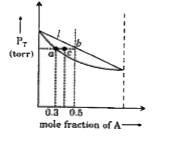Ammonium chloride crystallises in CsCl type (bcc) lattice with unit cell edge length of 387 pm. Distance between oppositely charged ions in the lattice and radius of the ion are respectively (if the radius of ion is 181 pm).Solution in Malayalam
356.12 pm, 175.12 pm
348.23 pm, 167.23 pm
335.15 pm, 154.15 pm
326.35 pm, 145.35 pm
The correct Answer is:C
In a bcc lattice, oppositely charged ions touch each other along the cross-diagonal of the cube.
So,
(b) Given that,
Topper's Solved these Questions
- SOLID STATEBOOK - BRILLIANT PUBLICATIONCHAPTER - SOLID STATEEXERCISE - LEVEL-II (ASSERTION - REASON TYPE)
20 Videos
- SOLID STATEBOOK - BRILLIANT PUBLICATIONCHAPTER - SOLID STATEEXERCISE - QUESTIONS
14 Videos
- SOLID STATEBOOK - BRILLIANT PUBLICATIONCHAPTER - SOLID STATEEXERCISE - LEVEL-I
50 Videos
- REDOX REACTION & ELECTROCHEMISTRYBOOK - BRILLIANT PUBLICATIONCHAPTER - REDOX REACTION & ELECTROCHEMISTRYEXERCISE - QUESTION (ELECTROCHEMISTRY) (LEVEL -II) (ASSERTION-REASON)
3 Videos
- SOLUTIONSBOOK - BRILLIANT PUBLICATIONCHAPTER - SOLUTIONSEXERCISE - Level-III (Linked Comprehension Type)
12 Videos
Similar Questions
Assertion : In any ionic solid [MX] with Schottky defects, the number of positive and negative ions are same.
Reason : Equal number of cation and anion vacancies are present.
View SolutionA compound of elements X and Y crystallizes in cubic structure where X atoms occupy the corners of the cube and Y atoms occupy the centre of the cube. What is the formula of the compound?
View SolutionThe radius of a di val ent cation M2+ is 94 pm and of divalent anion X2− is 146 pm. Thus, M2X2− has
View SolutionAssertion: After the electrolysis of aqueous CuSO4 solution pH decreases.
Reason: Sulphuric acid is formed.
View Solution1 mole of A and 1 mole B are mixed together to form an ideal solution at 25∘C. Solution is placed in a vessel fitted with piston. If pressure on the solution is reduced isothermally.

Correct relationship between P∘AandP∘B is
View SolutionAB crystallises in a bcc lattice with edge length qa equal to 387 pm.The distance between two oppositely chariged ions in the lattice is
View SolutionAmmonium chloride crystallizes in a body-centred cubic lattice with a unit distance of 387 pm. If the size of Cl− ion is 181pm, the size of NH+4 ion would be
View SolutionNH4Cl crystallizes in a body centred cubic lattice , with a unit cell distance of 387 pm. Calculate (a) the distance between the oppositely charged ions in the lattice and (b) the radius of the NH+4 ion if the radius of the Cl− ion is 181 pm.
View SolutionA compound AB crystallises in the b.c.c lattice with unit cell edge length of 390 pm. Calculate
(a) the distance between the oppsitely charged ions in the lattice.
(b) the radius of A+ ion if radius of B− ion is 175 pm.
View SolutionNH4Cl crystallises in a body centred cubic lattice with a unit cell distance of 387 pm. Calculate
(a) the distance between the oppositely charged ions in the lattice.
(b) the radius of NH+4 ion if that of Cl− ion is 181 pm.
View SolutionAmmonium chloride crystallises in a body-centred cubic lattice with a unit distance of 387 pm. Calculate (a) the distance between oppositely charged ions in the lattice and (b) and radius of the NH_(4)^(+) ion of the radius of Cl^(-) ion is 181 pm.
View SolutionA compound AB crystallises in bcc lattice with the unit cell edge length of 380 pm. Calculate (i) The distance between oppositely charged ions in the lattice. (ii) radius of B^(-) if he radius of A^(+) is 190 pm.
View SolutionA compound AB crystallises in bcc lattice with the unit cell edge length of 380 pm. Calculate (i) the distance between oppositely charged ions in the lattice ,(ii) radius of B^- if the radius of A^+ is 190 pm
View SolutionNH4Cl crystallizes in a body-centered cubic type lattice with a unit cell edge length of 387 pm. The distance between the oppositively charged ions in the lattice is
View SolutionAB crystallises in a bcc lattice with edge length ‘a’ equal to 387 pm. The distance between two oppositely charged ions in the lattice is
View Solution
